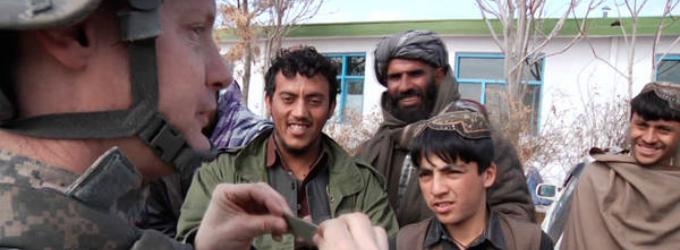
CALL ME EHSAAN
CALL ME EHSAAN, directed and filmed by Micah Garen, offers a look at the US military’s recent rebuilding operations in Afghanistan. Ehsaan is the name Lt Col John Loftis, US Airforce expert in Afghan language and culture, chooses for himself. It means, he explains, “beholden under obligation.”
Garen’s filming and direction are observant and straightforward; Loftis is diplomatic towards the camera and animated regarding his mission. Scenes of Loftis describing his experiences communicating with Afghanis in the streets and at cultural gatherings are juxtaposed with long shots of the landscape. There’s no music except chanting, the sounds underscored by the noises of military vehicles. The effect is atmospheric but not intrusive. Although there are plenty of moments for pause and reflection on the nature of Loftis’s mission, the gravity of what Loftis represents doesn’t settle until the sobering coda.

SUN
SUN is the second in director Jesse Daniel Lawrence’s series of portraits about the relationships between people and the places that inspire them. The film invites the viewer to accompany classical composer Malcom Lipkin on a walk through his beloved Lime Kiln Wood.
Idyllic in setting, the exploration of the wood is accompanied by Lipkin’s subtle narration. The tale of how the wood came to inspire Lipkin’s symphony, Sun, is followed by a meditation on the influence of the natural world on composition. SUN is nevertheless not without shadow. Lawrence matches Lipkin’s fascination with the thematic parallels between the sun’s journey across our vision and the cycle of a human life, with footage of the light in the woods, from start to fade. Lipkin’s symphony alternates with the sounds of the wood itself, connecting inspirational source to finished creation.

JUGGLE AND CUT
Fifteen year-old Andy Phelps saw himself as invincible. A kid with boundless interests (carpentry, hockey, juggling, and fire-breathing), he and some friends drove fast and reckless down a back road in his Michigan hometown. His friends died; Andy was paralyzed. JUGGLE & CUT, from director Caleb Slain, is Andy’s story.
Slain’s opening sequence, paired with Andy’s narration, is remarkably effective, suspenseful and foreboding. The rest of the film is equally well-paced, detailing Andy’s life after the accident, and the revelation of how he spends his time now. Slain uses setting, motion, and texture effectively, and doesn’t waste a shot. The film’s score, by Wlad Marhulets, is alternately rambunctious, and haunting, resonant with a tenacious optimism, not unlike Andy’s sense of self.

CANS OF HOPE
Hirokazu Kishida chronicles a community’s recovery in CANS OF HOPE. After the tsunami struck Japan in 2011, the town of Ishinomaki found that most of the output from its local canning company, Kinoya Ishinomaki Suisan, was buried in the mud and rubble of the factory. Offers to buy the buried cans were coming in, and the surviving employees set to digging them up and cleaning them for shipping and sale.
Ishinomaki’s resilience doesn’t need any added fanfare or dramatics, and
Kishida doesn’t make that mistake. There’s little by way of overt stylistics at work. The ceaseless activity of recovery is accompanied by stories of unfathomable loss, set against the backdrop of the devastation. Kishida captures the triumphs, small and large, of the determined community.

CENTRAL STATION SOFIA
CENTRAL STATION SOFIA, directed by Alberto Iordanov, is as much moving portraiture as it is good cinematography. In its depiction of the Balkans’ biggest rail station, each person in the camera’s eye emerges as a vivid character in the life of the station, which was built to serve crowds and now is sparsely utilized. Infrastructure decaying in a culture that can’t support it, the station itself emerges as a compelling persona.
The film tours an empty hotel, a restaurant with no customers and greatly reduced workstaff, and observes the impossibility of getting a train to Greece, while station pets prowl the premises and waiting passengers feed the sparrows. Two businesses still have customers: the gun shop and the lottery booth. Iordanov fills the film with tiny illustrative details and moments that alternate gravity and delight without jarring the viewer.

THE FORGOTTEN FRUIT
THE FORGOTTEN FRUIT, directed by James Williams, is a glimpse into the world of competitive gooseberry growing in the United Kingdom. The town of Egton Bridge, a village in North Yorkshire, holds the distinction of being the site of the oldest remaining gooseberry show in the country. The show is held, as it has been for over 200 years, by the Egton Bridge Old Gooseberry Society.
Williams showcases the Society members as they tend, harvest, and display the fruit of their labours. The competitive gooseberry-growing community may be small, but they’re dedicated and knowledgeable. Williams communicates both the pride of the Society and their sense of humour about the nature of gooseberry tending. The film is a succinct experience, but the charm lingers after the credits have rolled.
The Saturday finale takes place on 14 September from 6pm, when the Lyceum Bar and cafe open. Book tickets here.

